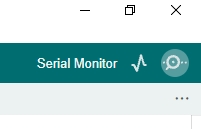Retrieve Last Data from Antares Server with MQTT Protocol
In this project you will be directed to send simple data from the Lynx-32 Development Board to the Antares IoT Platform using WiFi connectivity with the MQTT protocol.
Prerequisites
The materials required follow the General Prerequisites on the previous page. If you have not prepared the requirements on that page, then you can visit the following page.
General Prerequisites ESP32 Wi-FiThe additional materials specific to this project are as follows.
Antares ESP HTTP Library. This documentation uses the Antares ESP MQTT library version 1.0.
Follow These Steps
1. Run the Arduino IDE application
2. Opening Sample Programme
The following is the AntaresMQTTRetrieveLatestData example programme code
/*
This is an example sketch to subscribe to MQTT data on ESP8266
via the Antares IoT Platform.
MQTT server & port:
platform.antares.id, port 1338
MQTT topic:
/oneM2M/req/your-access-key/antares-cse/json
The main function in this sketch is the callback function,
which will be fired every time a new message is published
to the topic.
For more information, please visit https://antares.id/id/docs.html
*/
#include <AntaresESPMQTT.h>
#define ACCESSKEY "YOUR-ACCESS-KEY" // Antares account access key
#define WIFISSID "YOUR-WIFI-SSID" // Wi-Fi SSID to connect to
#define PASSWORD "YOUR-WIFI-PASSWORD" // Wi-Fi password
#define projectName "YOUR-APPLICATION-NAME" // Name of the application created in Antares
#define deviceName "YOUR-DEVICE-NAME" // Name of the device created in Antares
AntaresESPMQTT antares(ACCESSKEY);
unsigned long previousMillis=0;
unsigned long interval =5000;
void callback(char topic[], byte payload[], unsigned int length) {
/*
Get the whole received data, including the topic,
and parse the data according to the Antares data format.
*/
antares.get(topic, payload, length);
Serial.println("New Message!");
// Print topic and payload
Serial.println("Topic: " + antares.getTopic());
Serial.println("Payload: " + antares.getPayload());
// Print individual data
}
void setup() {
Serial.begin(115200);
antares.setDebug(true);
antares.wifiConnection(WIFISSID, PASSWORD);
antares.setMqttServer();
antares.setCallback(callback);
}
void loop() {
/*
Check if we're still connected to the MQTT broker/server.
If disconnected, the device will try to reconnect.
*/
antares.checkMqttConnection();
while(millis()-previousMillis > interval)
{
previousMillis = millis();
antares.retrieveLastData(projectName,deviceName);
}
}3. Set MQTT Parameters in Programme Code
Change the HTTP Protocol parameters in the following variables *ACCESSKEY, *WIFISSID, *PASSWORD, *projectName, and *deviceName. Adjust to the parameters in the Antares console.




4. Compile and Upload Program
Connect the Lynx-32 with your computer and make sure the Communication Port is read.
Set up the ESP32 board by clicking Tools > Board > esp32 in the Arduino IDE, then make sure the ESP32 Dev Module is used. Select the port according to the communication port that is read (in this case COM4). The result will look like the following image.

After all the setup is complete, upload the programme by pressing the arrow icon as shown below. Wait for the compile and upload process to finish
If the programme upload is successful, it will look like the following image.
After uploading the programme, you can view the serial monitor to debug the programme. The serial monitor icon is shown in the following image.

Set the serial baud rate to 115200 and select BothNL & CR. The result will look like the following image.
Make sure the serial baud rate matches the value defined in the programme code. If the serial baud rate is not the same between the programme code and the serial monitor, the ASCII characters will not be read properly.
5. Check Data in Antares
After uploading the programme successfully, then open the Antares device page and see if the data taken matches the data in the Antares Console.


Last updated